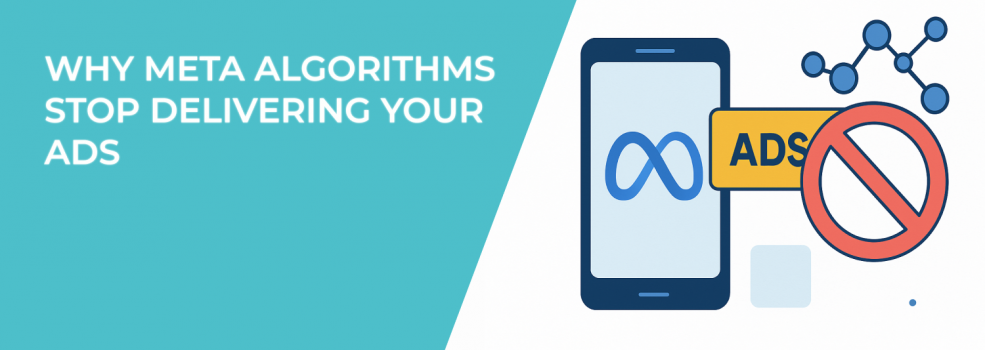Your Meta ads were running fine yesterday — then suddenly, impressions dropped to zero.
No warning, no error message that makes sense. Just silence.
If you’ve been there, you’re not alone. The truth is, Meta’s delivery system is incredibly sensitive. It runs on data, consistency, and performance feedback loops — and when one of those breaks, your ads can stall without notice.
Let’s unpack the real reasons behind “stopped delivery” and what you can do to restart it fast.
1. Your Ads Got Stuck in the Learning Phase
When you launch a new campaign, Meta’s algorithm enters what’s called the learning phase — a testing period when it explores your audience and creative combinations to predict who’s most likely to convert.
If your ad set doesn’t hit around 50 optimization events within seven days (like purchases, leads, or clicks, depending on your goal), Meta doesn’t have enough data to move beyond testing. That’s when performance stalls, and delivery often slows to a crawl.
To fix it:
-
Simplify your structure. Fewer ad sets with more data in each performs better than spreading your budget thin.
-
Avoid frequent edits. Changing targeting, budget, or creatives mid-phase restarts the process completely.
-
Raise the budget gradually — ideally by 20–30% at a time — to feed the algorithm more signals without causing a reset.
For a deeper breakdown on how to speed this process up, read How to Finish the Facebook Learning Phase Quickly.
2. Audience Fatigue and Overlap Are Killing Delivery
Meta wants your ads to stay relevant. When the same users see your ads repeatedly without interacting, the system assumes fatigue has set in and begins to limit delivery.
Even worse, overlapping audiences — where multiple ad sets compete for the same people — confuse the algorithm and increase your CPMs.
What to check:
-
Frequency: If it’s higher than 3–4, your audience may be saturated.
-
Audience size: Too narrow and you’ll burn through it in days.
-
Ad freshness: Rotate creatives every 7–10 days in active campaigns.
Try testing new segments with fresh interest stacks or lookalikes. Learn how in Facebook Ad Targeting 101: How to Reach the Right Audience.
You can also explore techniques like interest layering or combining behaviors and demographics. These help you reach adjacent buyers instead of showing the same people the same thing.
3. Meta’s Algorithm Lost Confidence in Your Creative
Ad delivery doesn’t just depend on your budget or targeting — it depends on how your audience reacts to your creative. Low engagement signals (like short watch times, poor click-through rates, or negative feedback) tell Meta your ad isn’t appealing enough to compete in auctions.
And since Meta ranks ads based on engagement quality, poor performance can push you out of the auction entirely.
To fix it:
-
Rework the first three seconds of your video or lead with a stronger hook in static ads.
-
Use human-centric visuals — faces, gestures, or relatable context tend to outperform product-only ads.
-
Test UGC-style content, or experiment with tools covered in The Best AI Text and Image Generators in 2024 to speed up creative testing.
-
Avoid ad fatigue by rotating assets before performance declines.
Also check your Quality Ranking, Engagement Rate, and Conversion Rate Rankings — Meta uses these metrics to determine delivery priority. A drop in any of them can quietly pull your ad out of the feed.
4. Your Campaign Objective Doesn’t Match Your Goal
Choosing the wrong campaign objective tells Meta to optimize for the wrong signal. For example, if you select “Traffic” but what you really need are leads or purchases, Meta will chase clicks, not conversions — and that affects how and where your ad gets shown.
Each objective triggers different machine learning models. Some focus on reach, others on conversion value or cost control. If your setup and goal don’t align, you’ll confuse the system and delivery stops.
Quick checklist before launch:
-
Verify that your conversion event matches your campaign objective.
-
Use Advantage+ or conversion-based objectives for better optimization signals.
-
Avoid “reach” campaigns unless your primary goal is awareness.
For clarity on how to choose the right campaign type, check Meta Ad Campaign Objectives Explained: How to Choose the Right One.
5. Your Budget, Bid, or Optimization Settings Are Misaligned
Even if your audience and creative are solid, Meta’s delivery engine can slow down when your budget or bid strategy doesn’t match auction conditions.
Common culprits include:
-
Budget too small for the chosen audience size (Meta can’t gather enough data).
-
Budget too high for a small audience, leading to early saturation.
-
Overly restrictive bid caps, which block you from winning auctions.
-
Daily budget spikes that reset learning or trigger underdelivery.
Here’s a balanced rule of thumb:
Keep your daily budget roughly 10x your target CPA (cost per action) and monitor cost stability for 72 hours before scaling.
If you’re using manual or cost-cap bidding, study Why You See “Ad Set May Get Zero” on Facebook and How to Fix It for detailed auction behavior insights.
6. Your Pixel or API Isn’t Sending Enough Conversion Data
Meta’s performance engine depends on accurate feedback — the pixel, Conversions API, and aggregated event setup all feed the algorithm with signals about user actions.
If those signals drop, the system has no proof that your ads are working. Over time, it deprioritizes delivery.
To check your setup:
-
Verify that all key events (ViewContent, AddToCart, Purchase, Lead) are firing correctly in Events Manager.
-
Cross-test pixel and CAPI data for mismatches or missing values.
-
Prioritize Aggregated Event Measurement for your most valuable conversions.
If you’re unsure whether tracking accuracy affects delivery, see Understanding Facebook Ad Statuses: Common Issues and How to Fix Them.
7. Too Many Edits, Too Often
Every time you edit your ad set — even small tweaks like changing targeting or adjusting your headline — Meta partially resets learning.
Frequent edits tell the algorithm, “Start over.” If that happens multiple times per week, delivery never stabilizes.
How to avoid it:
-
Make batch edits once or twice a week, not daily.
-
Keep an edit log to track which changes impacted delivery.
-
Wait at least 72 hours after edits before judging performance.
If you’re managing multiple campaigns and need to automate adjustments, Meta’s own automation tools can help. Check How to Use Automated Rules to Improve Facebook Campaign Efficiency for safe optimization workflows.
8. Competition and Auction Fluctuations
Sometimes, the issue isn’t you — it’s the market. During seasonal spikes (like holidays or Black Friday), competition increases, CPMs rise, and smaller budgets get squeezed out.
If you notice sudden delivery drops without major changes on your end, review your auction overlap diagnostics and cost per 1,000 impressions (CPM). If CPM doubled overnight, your ad may simply be losing auctions.
You can adapt by:
-
Scheduling ads for off-peak hours to reduce competition.
-
Using Advantage+ placements to let Meta find cheaper delivery pockets.
-
Testing lifetime budgets for more flexible pacing.
Learn more about how Meta’s auction works behind the scenes in Crack the Code: What You Need to Know About the Facebook Ad Auction.
9. Poor Post-Click Experience
Even when your ads look fine, Meta evaluates what happens after the click. If users bounce from your landing page too quickly, or if load speed is slow, the algorithm lowers your ad’s quality score — and stops sending traffic.
Fix the post-click layer:
-
Optimize your page for mobile first; over 90% of Meta traffic comes from phones.
-
Compress images and use short, scannable copy.
-
Ensure your CTA and value proposition appear above the fold.
Want to understand why this matters? Check Facebook Ads Not Converting: How To Fix It for in-depth troubleshooting steps.
The Takeaway
When Meta stops delivering your ads, it’s rarely one big issue — it’s a chain reaction.
A tracking misfire confuses targeting. Audience fatigue lowers engagement. Budget edits restart learning. Before long, the system loses confidence in your campaign.
The fix isn’t magic. It’s methodical:
-
Audit your data flow (pixel, API, events).
-
Simplify your campaign structure.
-
Refresh your creatives regularly.
-
Match your objective and budget to your actual goals.
If you build campaigns that make Meta’s algorithm easy to learn from — stable data, engaged audiences, clear objectives — your delivery won’t just recover. It’ll scale sustainably.

